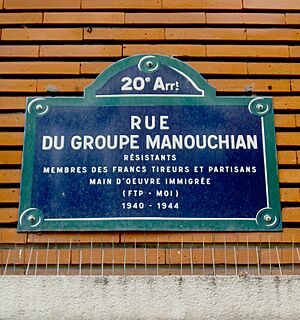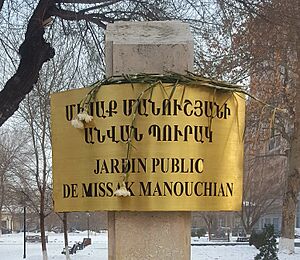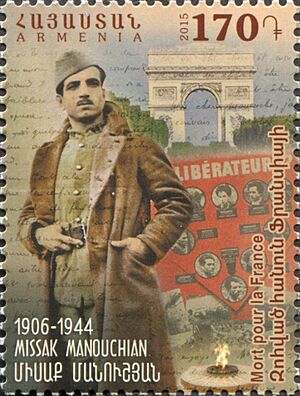Missak Manouchian facts for kids
Quick facts for kids
Missak Manouchian
|
|
|---|---|

Manouchian in the 1930s
|
|
| Born | 1 September 1906 |
| Died | 21 February 1944 (aged 37) Fort Mont-Valérien, Suresnes, Occupied France
|
| Cause of death | Execution by firing squad |
| Resting place | Ivry Cemetery, Ivry-sur-Seine |
| Other names | Michel Manouchian (francized) |
| Occupation | Trade unionist, poet, translator, political activist |
| Organization | FTP-MOI |
| Political party | French Communist Party (from 1934) |
| Movement | Labour movement, Anti-fascism, French Resistance |
| Spouse(s) | Mélinée (née Assadourian) |
Missak Manouchian (born September 1, 1906 – died February 21, 1944) was a brave French-Armenian poet and activist. He was a survivor of the terrible Armenian genocide. In 1925, he moved to France from an orphanage in Lebanon.
During World War II, Manouchian became a leader in the FTP-MOI. This was a special group of the French Resistance. It was made up of immigrants, including many Jewish people, living in the Paris area. His group carried out important attacks against Nazi targets. Many people believe the Manouchian group was the most active Resistance group.
Manouchian and many of his friends were arrested in November 1943. The Nazis executed them at Fort Mont-Valérien on February 21, 1944. Today, Missak Manouchian is remembered as a true hero of the French Resistance.
Contents
Early Life and Moving to France
Missak Manouchian was born on September 1, 1906, in a small village called Adıyaman. This area was part of the Ottoman Empire at the time. His family were farmers.
When he was young, a terrible event called the Armenian genocide happened in 1915. His parents were killed, but Missak and his brother managed to survive. In the early 1920s, he found a home in an orphanage in Jounieh, Lebanon. This orphanage was run by the Armenian General Benevolent Union. Lebanon was then under French control.
He got an education at the orphanage. In 1925, he decided to move to France to start a new life.
Life in Paris and Learning New Skills
Missak Manouchian eventually settled in the big city of Paris. He found a job working with machines at a Citroën car factory. He was a "lathe operator," which means he used a machine to shape metal.
During this time, he taught himself many things by reading. He often visited libraries in the Latin Quarter of Paris. He joined a large group called the General Confederation of Labour (CGT). This group was one of the first major trade unions in France. Trade unions help workers get fair pay and good working conditions.
In the early 1930s, a worldwide economic crisis called the Great Depression hit. Missak Manouchian lost his job. He didn't like the way capitalism worked, where businesses are privately owned. To earn money, he sometimes posed as a model for artists who made sculptures.
Becoming a Writer and Activist
In 1934, Manouchian joined the French Communist Party. This political party believed that everyone should be equal and that the government should control businesses.
From 1935 to 1937, he was the editor of a newspaper called Zangou. This newspaper was written in the Armenian language. It was named after a river in Armenia. The newspaper spoke out against fascism, which is a type of government that is very controlling and often racist. It also spoke against imperialism, where one country controls others. The newspaper supported the Soviet Union.
Writing Poetry and Translating Books
Manouchian loved to write poetry. He and his Armenian friend, Séma, started two literary magazines. They were called Tchank ("Effort") and Mechagouyt ("Culture"). These magazines published articles about French literature and Armenian culture.
Missak and Séma worked together to translate poems by famous French writers. They translated works by Baudelaire, Verlaine, and Rimbaud into Armenian. This was the first time many of these poems were available in Armenian. Both Manouchian and Séma also attended classes at the Sorbonne. They studied literature, philosophy, economics, and history.
In 1935, Manouchian became the secretary of the Relief Committee for Armenia (HOC). This group was connected to the MOI, which helped immigrant workers. At a meeting for the HOC, he met Mélinée Assadourian. She later became his wife.
World War II and the French Resistance
When World War II began in September 1939, Manouchian had to leave Paris because he was a foreigner. He found work in the Rouen area, again as a lathe operator. After France was defeated in June 1940, he returned to Paris. He found that his political activities were now against the law. The French government had banned the Communist Party in 1939.
On June 22, 1941, the Nazis invaded the Soviet Union. Manouchian was arrested in Paris during a round-up of communists. He was held in a prison camp. But thanks to his wife, Mélinée Assadourian, he was released after a few weeks.
Manouchian became a political leader for the Armenian section of the underground MOI. In February 1943, he joined the FTP-MOI. This was a group of fighters and saboteurs in Paris. They carried out secret attacks.
Leading the Manouchian Group
Manouchian became the leader of the FTP-MOI in the summer of 1943. He took charge of three groups, with about 50 fighters in total. The Manouchian group is famous for assassinating General Julius Ritter on September 28, 1943. Ritter was a Nazi official in France who forced people to work for the Germans. The attack was carried out by brave fighters like Marcel Rayman, Léo Kneller, and Celestino Alfonso.
From August to November 1943, Manouchian's groups carried out almost 30 successful attacks against German interests. The famous singer Charles Aznavour and his family were also part of the Manouchian resistance group. After the war, they were recognized for helping to save Jewish and Armenian people from the Nazis.
Arrest and Execution
On November 16, 1943, French police, who were working with the Nazis, arrested the Manouchian group. This happened in a place called Évry-Petit Bourg. Luckily, Manouchian's wife, Mélinée, managed to escape.
Manouchian and the others were questioned harshly to get information. They were then handed over to the German secret police. The 23 members of the group were put on a public trial in 1944. This trial was used by the Nazis for propaganda, to scare others.
Manouchian and 21 of his friends were shot at Fort Mont-Valérien near Paris on February 21, 1944. The last group member, Olga Bancic, was sent to Stuttgart and executed there in May 1944.
In his last letter to his wife, Mélinée, Manouchian wrote that he forgave everyone. But he did not forgive "the one who betrayed us to save his skin and those who sold us." It was believed that a member named Joseph Davidovitch betrayed them. He was arrested and tortured by the Nazis, then later killed by other Resistance members. Some also felt that the French Communist Party might have put the group in danger.
In December 2009, photographs of French Resistance agents facing a Nazi firing squad were found. These photos were identified as Manouchian and his group. Since June 2010, these powerful photographs have been on display at Fort Mont-Valérien.
Remembering Missak Manouchian
After World War II, Armenians in France were seen in a very positive light. This was because of Missak Manouchian's important role in fighting the Nazis. Manouchian is a very important figure in the friendship between Armenia and France. In 2022, the Mayor of Marseille, Benoît Payan, suggested that Manouchian should be buried in the Panthéon in Paris. This is a special place where France's greatest heroes are laid to rest.
In 2007, an exhibition about Manouchian was held at the Musée Jean Moulin in Paris. This was part of a special year celebrating Armenia in France. On February 21, 2014, 70 years after his execution, a ceremony was held at Fort Mont-Valérien. Important people attended, including French President François Hollande and Armenian Foreign Minister Eduard Nalbandyan. The famous French-Armenian singer Charles Aznavour was also there.
On March 13, 2014, the Missak Manouchian Park was opened in Yerevan, the capital of Armenia. Presidents Serzh Sargsyan and Hollande were present for the opening.
A street in Paris, in the 20th arrondissement of Paris, was named after the Manouchian Group in 1955. In 1978, a statue of Manouchian was placed in the military cemetery of Ivry-sur-Seine, near Paris.
A special plaque was put up on February 22, 2009, at 11 rue de Plaisance in Paris. This old hotel was the last home Missak and Mélinée Manouchian shared. In February 2010, statues of Manouchian were also unveiled in Marseille and Issy-les-Moulineaux.
Because he was a communist, Manouchian was quickly seen as a hero in the Soviet Union. A school in Yerevan, Armenia, was named after Manouchian in 1963.
Considering the Panthéon
In January 2022, a campaign began to move Manouchian's ashes to the Panthéon. This campaign was supported by many people, including mayors and historians. French President Emmanuel Macron has also shown interest in this idea. Moving his remains to the Panthéon would be a huge honor, recognizing him as a national hero of France. The ceremony is likely to happen in early 2024, around the 80th anniversary of his execution.
See also
 In Spanish: Missak Manouchian para niños
In Spanish: Missak Manouchian para niños
- Affiche Rouge (Red Poster)






